
The Araceae are a family of monocotyledonous flowering plants in which flowers are borne on a type of inflorescence called a spadix. The spadix is usually accompanied by, and sometimes partially enclosed in, a spathe. Also known as the arum family, members are often colloquially known as aroids. This family of 114 genera and about 3,750 known species is most diverse in the New World tropics, although also distributed in the Old World tropics and northern temperate regions.

Amorphophallus is a large genus of some 200 tropical and subtropical tuberous herbaceous plants from the Arum family (Araceae), native to Asia, Africa, Australia and various oceanic islands. A few species are edible as "famine foods" after careful preparation to remove irritating chemicals. The genus includes the Titan arum of Indonesia, which has the largest inflorescence of any plant in the genus, and is also known as the 'corpse flower' for the pungent odour it produces during its flowering period, which can take up to seven years of growth before it occurs.

In botany, a spadix is a type of inflorescence having small flowers borne on a fleshy stem. Spadices are typical of the family Araceae, the arums or aroids. The spadix is typically surrounded by a leaf-like curved bract known as a spathe. For example, the "flower" of the well known Anthurium spp. is a typical spadix with a large colorful spathe.

Philodendron is a large genus of flowering plants in the family Araceae. As of June 2024, the Plants of the World Online accepted 621 species; other sources accept different numbers. Regardless of number of species, the genus is the second-largest member of the family Araceae, after genus Anthurium. Taxonomically, the genus Philodendron is still poorly known, with many undescribed species. Many are grown as ornamental and indoor plants. The name derives from the Greek words philo- 'love, affection' and dendron 'tree'. The generic name, Philodendron, is often used as the English name.
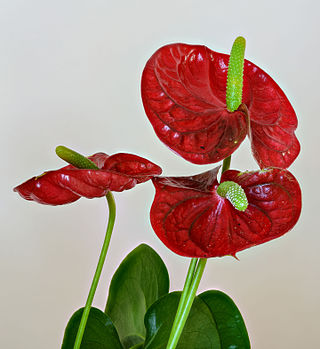
Anthurium is a genus of about 1,000 species of flowering plants, the largest genus of the arum family, Araceae. General common names include anthurium, tailflower, flamingo flower, pigtail plant, and laceleaf.

Spathiphyllum is a genus of about 47 species of monocotyledonous flowering plants in the family Araceae, native to tropical regions of the Americas and southeastern Asia. Certain species of Spathiphyllum are commonly known as spath or peace lilies.
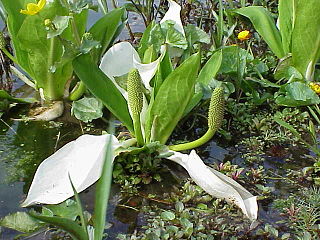
Lysichiton is a genus in the family Araceae. These plants are known commonly as skunk cabbage or less often as swamp lantern. The spelling Lysichitum is also found. The genus has two species, one found in north-east Asia, the other in north-west America.
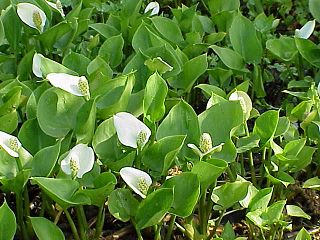
Calla is a genus of flowering plant in the family Araceae, containing the single species Calla palustris.

Arum is a genus of flowering plants in the family Araceae, native to Europe, northern Africa, and western and central Asia, with the highest species diversity in the Mediterranean region. Frequently called arum lilies, they are not closely related to the true lilies Lilium. Plants in closely related Zantedeschia are also called "arum lilies".

Spathiphyllum wallisii, commonly known as peace lily, white sails, or spathe flower, is a very popular indoor house plant of the family Araceae. The genus name means "spathe-leaf", and the specific epithet is named after Gustav Wallis, the German plant collector. It was first described in 1877.
Carlephyton is a genus of four species in the family Araceae, all endemic to Madagascar.

Callopsis is a monotypic genus from the plant family Araceae and has only one species, Callopsis volkensii. This plant forms a creeping rhizome and has cordate-ovate leaves that are medium green and glabrous. The inflorescence is typical of the family Araceae, with a white spathe and yellow spadix. The spadix is shorter than the spathe and its male and female flowers are separated shortly.
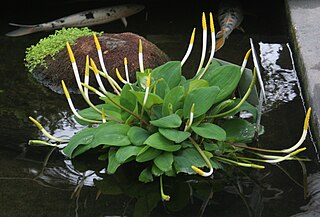
Orontium aquaticum, sometimes called golden-club, floating arum, never-wets or tawkin, is a species of flowering plants in the family Araceae. It is the single living species in the genus Orontium, which also contains several extinct species described from fossils. O. aquaticum is endemic to the eastern United States and is found growing in ponds, streams, and shallow lakes. It prefers an acidic environment. The leaves are pointed and oval with a water repellent surface. The inflorescence is most notable for having an extremely small almost indistinguishable sheath surrounding the spadix. Very early in the flowering this green sheath withers away leaving only the spadix.

Lagenandra is a genus of aquatic flowering plants in the aroid family, Araceae, endemic to the Indian Subcontinent. The genus has gradually become more known through the aquascaping and aquarium hobby, in which several related Araceae genera are already highly prized and grown on a large scale ; Lagenandra, however, is still relatively rare in cultivation or private collections.
Furtadoa is a genus of flowering plants in the family Araceae. It consists of only two species: Furtadoa mixta and Furtadoa sumatrensis.
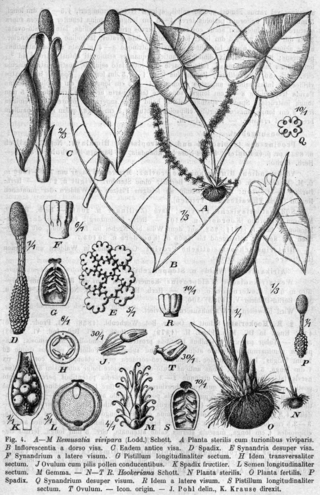
Remusatia is a genus of flowering plants in the family Araceae. It contains 4 known species, one of which was described in 1987. This species was initially placed in genus Gonatanthus called Gonatanthus ornatus. After the genus had been sunk into Remusatia its new name was Remusatia ornatus, but it was later changed to Remusatia hookeriana.

Spathicarpa is a genus of flowering plants in the family Araceae, all of which are endemic to South America. Spathicarpa species are notable for the fact that the entirety of their spadix is fused to the spathe. The genus is believed to be closely related to Spathantheum. The tribe Spathicarpeae is named after the genus Spathicarpa.

Anthurium andraeanum is a flowering plant species in the family Araceae that is native to Colombia and Ecuador. It is a winner of the Royal Horticultural Society's Award of Garden Merit.

Zantedeschia albomaculata, commonly called the spotted calla lily or the white spotted arum, is a species of flowering plant in the arum family, Araceae. Its leaves are somewhat smaller, thinner and slightly more pointed than the larger Zantedeschia aethiopica—also commonly called the "calla lily"—and display attractive white speckling on their faces. The plant spreads laterally underground by way of a rhizome or tuber, with nodes that sprout and send-up new shoots. Its inflorescence is typical of the Araceae family, featuring a white, funnel-shaped spathe with a yellowish spadix in the center.
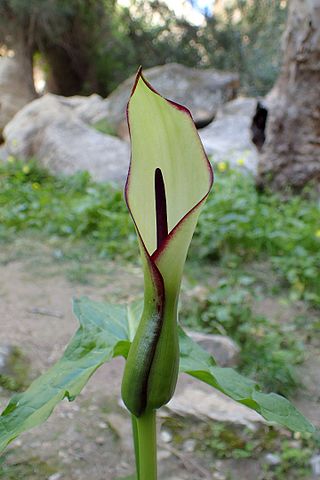
Arum hygrophilum is a species of flowering plant in the family Araceae. It has a disjunct distribution, found in Israel, Jordan, Lebanon, Syria, Cyprus and Morocco.

















